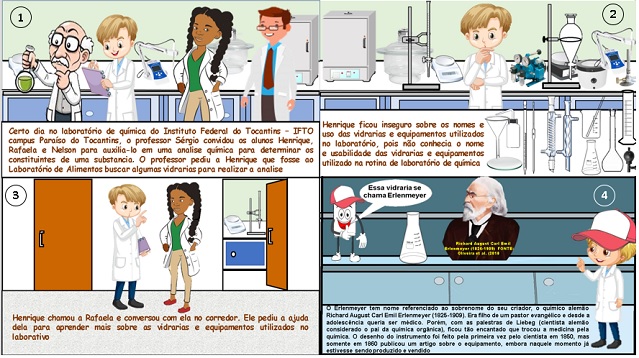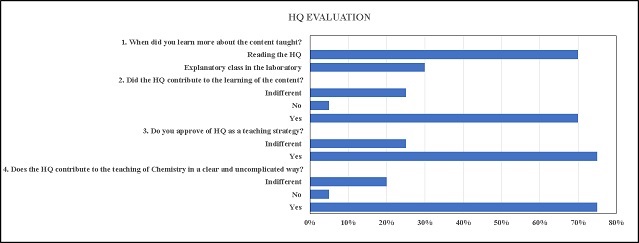Autores
Rodrigues, H.P. (IFTO CAMPUS PARAÍSO DO TOCANTINS) ; Viroli, S.L.M. (IFTO CAMPUS PARAÍSO DO TOCANTINS) ; Ramos, M.L. (IFTO CAMPUS PARAÍSO DO TOCANTINS) ; Rempel, G.H.C. (IFTO CAMPUS PARAÍSO DO TOCANTINS)
Resumo
The use of innovative teaching practices in the classroom is necessary to arouse
students' interest so that learning is not monotonous, mechanical and tiring. The
work evaluated the production of a comic book (HQ) about the use of glassware in
experimental classes in Chemistry. The study was carried out with the intention
of evaluating the production of a HQ. Project fellows provided structured scripts
and explanations about the names and uses of the glassworks. After the
explanations, they distributed comics produced by the scholarship holders to each
student. After reading the HQ, an evaluative questionnaire was applied with the
following closed questions. The HQ produced helped to establish and contribute to
the learning of the content, promoting a pleasant and fun atmosphere.
Palavras chaves
Chemistry Teaching; Learning object; meaningful learning
Introdução
Learning objects (LO) are physical or virtual resources that contribute to the
teaching, learning and knowledge of students, contributing to pedagogical
practice inside or outside the classroom (ALVES, 2020). The application of
learning objects in the classroom stimulates students' interest and learning in
a dynamic, participatory, motivating, pleasant way, unlike fragmented,
decontextualized teaching, with memorization of rules and laws where the student
occupies a passive position throughout the teaching process, contributing in an
unsatisfactory way to the quality of teaching and learning (OLIVEIRA et al.,
2018a; OLIVEIRA et al. 2018b). Comic books (HQs) are one of the options offered
as learning objects that can collaborate with the teaching-learning process of
students, enabling the development of Chemistry content in a simple way through
drawings and creative stories close to the student's daily life (GONÇALVES et
al. al. 2019; OLIVEIRA et al. 2019). The mixture of words with images narrated
through the story presented in a fictitious or real way can provoke the
reflections of student readers and be explored by the teacher for discussion,
illustration of an idea, presentation, problematization and contextualization of
scientific content at all levels of schooling. (LEITE, 2017; SALAPATA; PERES,
2017). Teachers must be aware of the potential and use strategies of comics, so
that they do not understand them as a mere resource for storing information for
students' fun and entertainment (BORGES, SÁ, LUZ Jr, 2021). Given the above, the
present work evaluated the production of comics (HQ) on the names, usability and
applicability of glassware used in experimental classes in Chemistry.
Material e métodos
The study was carried out in an exploratory and descriptive way with a
quantitative approach (GIL, 2008) with the intention of evaluating the
production of a comic book developed for teaching recognition, usability and
applicability of glassware used in experimental activities in Chemistry classes.
The research was carried out at the Federal Institute of Education, Science and
Technology of Tocantins IFTO Paraíso do Tocantins campus during the extension
project expanding the teaching of chemistry through comics in public schools
involving 40 students of the 1st year of high school from State College Dr.
Valdecy Pinheiro, located in the city of Rio dos Bois. The students visited the
IFTO Paraíso do Tocantins campus to see the glassware and equipment of the
General Chemistry laboratory. During the stay in the laboratory, two moments
were performed. In the 1st moment, the grantees of the project provided a
structured script and explanations about the names and use of the glassworks. In
the 2nd moment, after the explanations and collection of the structured scripts,
a HQ (Figure 1), produced by the scholarship holders, was delivered to each
student involving the nomenclature, usability and applicability of the basic
glassware used in classes in the Chemistry laboratory. For the production of the
comics, image editing and digital illustration software, digitizing table, and
websites about creating comics were used. After reading the HQ, an evaluative
questionnaire was applied with the following closed questions: 1. When did you
learn more about the content taught? 2. Did the HQ contribute to the learning of
the content? 3. Do you approve of HQ as a teaching strategy? 4. Can HQ
contribute to the teaching of Chemistry concepts in a clear and uncomplicated
way?
Resultado e discussão
According to graph 1, 70% of the students learned more about the content taught
by reading the HQ. The use of HQ as a methodological strategy provided
significant learning. According to Nunes and Lima (2020), the contextualization
of the proposed problem situations facilitates the association of concepts,
providing an understanding of how chemistry is present in everyday life.
Regarding the contribution of HQ to content learning, 70% stated that there was
a contribution to content learning. According to Klein and Barin (2019), the use
of comics as a pedagogical resource is an innovative resource in the use of
chemistry teaching and learning. When asked about approving the HQ as a teaching
strategy, there was an approval of 75% and there was a contribution of 75% in
teaching the subject of Chemistry in a clear and uncomplicated way using the HQ.
Cardoso et al. (2022) performing activities in the teaching of Chemistry with
HQS in high school found rates of 79.2% for facilitation and understanding of
the chemical concepts studied and 66.7% innovative experience. Gomes et al.
(2017), proposing the construction of comics by public school students to learn
chemistry concepts, obtained fun learning results and ease of acceptance of
student content by students. Leite (2017), investigating the use of two digital
tools in the preparation of comics by students, also found favorable results for
the use of comics as a strategy for teaching chemical concepts and the
possibility of different learning contexts. Da Silva et al, (2016) using an LO
for teaching about laboratory glassware, declare that the influence of LO exerts
on students makes the teaching and learning process easier and more dynamic.


Conclusões
This work addressed an action carried out with students from the 1st year of high
school evaluating a comic book (HQ) produced on the glassware used in the
experimental classes. The evaluation presented satisfactory results, where all
the evaluated items presented values equal to or greater than 70% of approval.
The HQ produced helped to establish and contribute to the learning of content on
recognition, usability and applicability of glassware and equipment, used in the
experimental activities of Chemistry classes, promoting a pleasant and fun
atmosphere.
Agradecimentos
TO GOD, to the IFTO Paraíso do Tocantins campus
Referências
ALVES, T. R. de S. Os objetos de aprendizagem no ensino de química: um levantamento exploratório junto a professores do ensino médio. Revista Scientia Naturalis, v. 2, n. 2, p. 508-524, p.508-524. 2020. Disponível em: https://periodicos.ufac.br/ index.php/SciNat/article/view/3820/2396. Acesso em: 10 mar. 2022.
BORGES, Ronaldo da Silva; SÁ, Ézio Raul Alves de; LUZ Jr., Geraldo Eduardo da. O “sim” do ensino de química às histórias em quadrinhos: um recorte do estado da arte. Revista Insignare Scientia-RIS, v. 4, n. 6, p. 205-227, 2021. Disponível em: https://periodicos.uffs.edu.br/index.php/RIS/article/view/12274/8171. Acesso em: 6 mar. 2022
CARDOSO, A.; ARAUJO, L.; LIU, A.; DE CASTRO, M. Histórias em Quadrinhos como Estratégia Didática para o Ensino de Química em Tempos de Pandemia. Revista Insignare Scientia - RIS, v. 5, n. 2, p. 55-74, 23 jun. 2022. Disponível em: https://doi.org/10.36661/2595-4520.2022v5n2.12990. Acesso em: 5 maio.2022.
DA SILVA, P, D.; Martins, S. D.; SILVA E SOUZA, S.H.; DA COSTA, B. I.C.; CARVALHO, de S. E.; DOS SANTOS S, A. Baralho das vidrarias como proposta alternativa para o ensino de vidrarias de laboratório. In: CONGRESSO BRASILEIRO DE QUIMICA, 56., 206, Belém. Anais Eletrônicos [...]. Belém, 2016. Disponível em: https://www.abq.org.br/cbq/2016/trabalhos/6/10142-18456.html. Acesso em: 21 maio 2022.
GIL, A. C. Métodos e técnicas de pesquisa social. Antônio Carlos Gil. - 6. ed. - São Paulo: Atlas,2008.
GOMES, M. das G.; SANTOS, F. M.; DIÓGENES, D. O.; FREITAS, A. D. L. de; MATIAS, D. P. Confecção de Histórias em Quadrinhos na melhoria do aprendizado de química no ensino médio. Revista de Ensino de Ciências e Matemática, v. 8, n. 2, p. 28-38, 2017. Disponível em:https://doi.org/10.26843/rencima.v8i2.1185. Acesso em: 10 maio 2022.
GONÇALVES, A.C.C.; DE SOUSA, A.C.A.; CUNHA, J.N.F.; PATRÍCIO, J.C.; SCHWINGEL, J.F.; ESGALHA, S.P.V. Aplicação do jogo didático inclusivo missão orgânica no Instituto Federal de Mato Grosso. In: CONGRESSO BRASILEIRO DE QUIMICA, 59., 2019, João Pessoa. Anais Eletrônicos [...]. João Pessoa, 2019. Disponível em: https://www.abq.org.br/cbq/2019/trabalhos/6/999-27912.html. Acesso em: 21 maio 2022.
KLEIN, V.; BARIN, C. S. Histórias em quadrinhos como elemento de flexibilização do ensino de química. Revista Brasileira de Ensino de Ciência e Tecnologia, v. 12, n. 1, p. 54-68, 2019. Disponível em: https://periodicos.utfpr.edu.br/ rbect/article/view/8024. Acesso em: 14 mar. 2022
LEITE, S. Histórias em quadrinhos e ensino de química: propostas de licenciandos para uma atividade lúdica. Revista Eletrônica Ludus Scientiae, [S. l.], v. 1, n. 1, 2017.Disponível em: https://revistas.unila.edu.br/relus/article/view/748. Acesso em: 10 mar. 2022.
NUNES, K. S. dos S.; LIMA, R. C. P. de. Utilização das Histórias em Quadrinhos em uma Sequência Didática Fundamentada nos Princípios da Teoria da Aprendizagem Significativa para o Estudo de Funções Inorgânicas. Boletim do Museu Integrado de Roraima (Online), v. 13, n. 01, p. 57–70, 2020. Disponível em: https://periodicos.uerr.edu.br/index.php/bolmirr/article/view/882. Acesso em: 20 jun. 2022.
OLIVEIRA, I. T. de; ZUCCHERATTO, K. M. C.; GRANADO, I. Z.; MELLO, P. H.de; OLIVEIRA, H. P. M. de. De onde vêm os nomes das vidrarias de laboratório? Química Nova. v. 41, n. 8, pp. 933-942. 2018a. Disponível em: https://doi.org/10.21577/0100-4042.20170240. Acesso em: 11 jun. 2022.
OLIVEIRA, A. L.; OLIVEIRA, J. C. P. DE; NASSER, M. J. S.; CAVALCANTA, M. P. O jogo educativo como recurso interdisciplinar no ensino de química. Revista Química nova escola. vol. 40 nº 2, p.89-96. 2018b. Disponível em: http://qnesc.sbq.org.br/online/qnesc40_2/05-RSA-82-16. Acesso em: 20 mar 2022.
OLIVEIRA, P. D.; BARROSO, G, R.; CARVALHO, N, F.; RIBEIRO, dos S. K.; DONZA, S. M. V.; DE BRITO, V. M.; PANTOJA, C. M. Estudo de ligações químicas: aplicação de um jogo didático e sua importância para o ensino de química em um cursinho popular de Belém do Pará. In: CONGRESSO BRASILEIRO DE QUIMICA, 59., 2019, João Pessoa. Anais Eletrônicos [...]. João Pessoa, 2019. Disponível em: https://www.abq.org.br/cbq/2019/trabalhos/6/455-27262.html. Acesso em: 11 maio 2022.
SANTOS, V.J.R.; GARCIA, R.N. A pesquisa sobre o uso dos quadrinhos no ensino das Ciências da Natureza apresentadas nos ENPECs de 1997 a 2015. In: Encontro Nacional de Pesquisa em Educação em Ciências, 11, 2017, Florianópolis. Anais... Florianópolis, 2017. Disponível em: http://www.abrapecnet.org.br/enpec/xi-enpec/anais/resumos/R1921-1.pdf. Acesso em: 3 mar. 2022
SALAPATA, A.; PERES, L. A Potencialidade do Uso de Histórias em Quadrinhos (HQs) como Linguagem no Processo Ensino e Aprendizagem. In: ENCONTRO DE DEBATES SOBRE O ENSINO DE QUÍMICA, 37., 2017, Rio Grande. E-book do 37° Encontro de Debates sobre o Ensino de Química: EDEQ - 37 anos: Rodas de Formação de Professores na Educação Química. Rio Grande: Editora da Furg, 2018. p. 1294-1301. Disponível em: https://edeq.furg.br/images/arquivos/trabalhos-completos/s17/ficha-298.pdf. Acesso em: 08 mar. 2022.
















